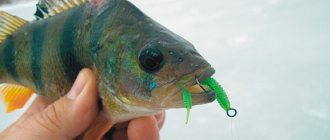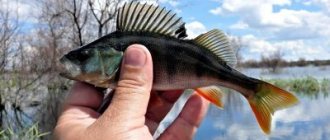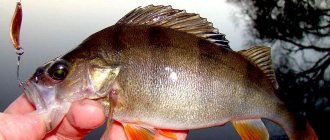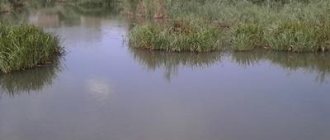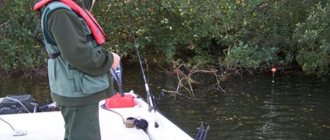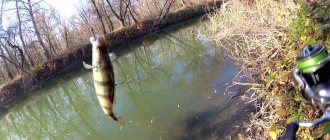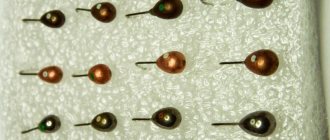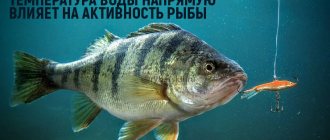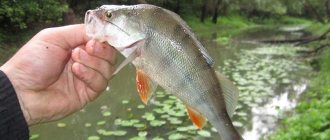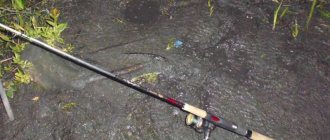Fishing for perch in winter is not a very common and rather narrow direction in fishing.
Most often they are used on larger predatory fish, such as pike or pike perch. Catching a perch on them is more a rarity than a regularity. In winter, perch is usually caught using a jig, a balance beam or a spoon.
This is a common misconception. This type of fishing can be very exciting, exciting and very productive. This has been proven more than once by winter fishing masters. You just need to know a few subtleties. It is possible that it may become your favorite type of winter hunting..
At the same time, many new anglers often have many questions. The topic is narrowly focused, there is little information. Undoubtedly, it has its pros and cons.
Pros and cons of fishing with a zherlitsa
One of the advantages is the speed of fishing. The striped predator sometimes reacts to the bait immediately after the bait sinks to the bottom. Swallows it deep into the stomach. With the right choice of fishing location, bites can come in succession. There is a high chance of catching 4-5 fish from one hole. Their size will not be large. As a rule, a school of perch weighing 300-400g.
But this does not mean that big fish cannot be caught. Just the opposite. The chance of catching a humpback whale weighing more than half a kilogram is just as great.
A perch girder is also irreplaceable under unfavorable conditions. It was a dead winter or there was a sharp change in temperature. Fish activity drops. It does not respond well to artificial baits. Fishing with live bait using a zherlitsa is an ideal option.
Constantly moving and drilling holes in winter is inconvenient and time-consuming. Setting traps for perch is more effective than running fishing.
Another advantage can be considered the excitement during fishing. Taking off from the spot the moment the red flag is raised. Hooking and landing perch is not boring fishing.
The disadvantages of this type of winter fishing for striped predators include immobility. If the bite is not successful, then moving the traps takes a lot of time and effort. The vents are a three-dimensional structure. And you need at least 5-6 of them.
Also, the presence of large predators in a reservoir can significantly interfere. Tackle for perch is not so durable and a large predator can easily ruin it.
Choosing a time and place for catching perch with girders
At the beginning and end of winter, when the fish are most active, fishing for perch on girders brings the best results. But at the same time, other gear - a jig rod and a trolling rod - often brings results no worse, so you can prefer them. But in the dead of winter, when the fish are passive, girders often help out fishermen. They often bring the best catches, and sometimes save them from complete lack of bite.
It’s also useful to read: How to make a winter fishing rod with your own hands
Since perch remains active throughout the winter, you can catch it with ice girders in any reservoir where it is found. But some water areas are better suited for such fishing, while others are worse.
Zherlitsa prove to be especially effective when hunting for large trophy minke whales. They can also be used to catch medium-sized perch. It is not advisable to hunt small fish with such gear. Accordingly, you need to fish where there are large fish.
These can be large rivers and lakes, as well as reservoirs. On small bodies of water, and often on medium ones, there is no point in catching perch in winter using girders.
Large fish tend to stay further from the shore. It is there that you need to catch it with girders. A good option would be fishing on underwater shallows (banks and ridges) with vegetation and shell rocks. Fish are also attracted to holes, edges and snags.
Design of the vents
What exactly are zherlits? It's essentially a trap. In common parlance - live bait.
Based on the installation principle, they can be divided into two types:
- supraglacial
- subglacial
The set of basic structural elements depends on the type.
They are left under the ice for a long time, often overnight. Periodically check for the presence of a catch or the absence of bait. They do not require constant monitoring. They are also called self-traps or postavushki. The simplest type of girders. She has no bite signal.
You can determine whether it was or not only by the winding on the hose. If the line is reeled in, then there was a bite. This fishing is called passive, for the lazy. Sometimes snowfall creates a problem. It's hard to find your live baits. Experienced fishermen make mounds of snow over the holes with stuck sticks or reeds.
The design is simple and uncomplicated. It is quite possible to make it yourself from scrap materials.
Wire (rope), fishing line, pipe (hose), weight, fishing line, hook, bait are attached to the crossbar in strict sequence. The crossbar can be made of wooden beams. The main thing is that it is strong and at least 2.5 times wider than the hole. Wire (rope) is used because it will not break when frozen into the ice. They are easier to remove from under the ice. In this case, the fishing line remains intact.
Above-ice vents have a signaling device in the form of a brightly colored flag. The main thing distinguishes them from those under the ice. Its function is to inform about the beginning of the bite.
As soon as the flag is raised, this is a signal for active action. Run faster, hook, fish! Waiting for this signal adds incredible excitement, courage and sportiness to this type of winter fishing. And if several flags go off at the same time, then there is no time for boredom, the adrenaline goes off scale.
There are no differences in the design of above-ground vents. The basic elements are the same:
- the base of the vent (plastic, wooden or metal disk);
- flag (bite alarm);
- reel with base (reel).
Such models are produced by many manufacturers. The principle of operation is similar for all. The predator grabs the bait. The line stretches and unwinds from the reel. The bright signal rises up and reports a bite. Then everything depends on the reaction speed and skills of the fisherman.
Different ice baits are suitable for different weather conditions.
On the platform - more universal, for any weather and ice cut. They are stable, lightweight, and collapsible. They are usually preferred when purchasing.
On a rail - they take up little space, but are not suitable for bare ice or snow. There is nothing to attach the rail to.
The so-called tripod is less stable and does not protect the hole from snow.
The horizontal one has the same disadvantages.
There are several models of foreign origin. They are equipped with electronic devices for recording the depth and footage of the reeled fishing line. But since operating conditions in the latitudes of America and Russia are different, such models have not found widespread use.
Features and secrets
The main thing in winter fishing for perch using a girder is to find a school’s camp site. The angler must constantly move the bait in search of fish. When fishing on clear sunny days, especially in shallow water, the holes are shaded with special circles or sludge. Many purchased flags already have such a circle at the base. The humpback whale can be very cautious in winter, so you should not make noise, run on the ice, or drop objects - you can scare off the flock. Sometimes perch bait gives good results in winter. It is needed when you need to lure a predator wandering across a large area of water. This is noticeable when rare bites occur on supplies located far away.
Equipment Features
What is a perch girder and how is it different from girders for other fish?
Features begin when choosing equipment. After all, their wrong choice can affect the entire course of fishing.
Perch is a predatory fish, active and boldly attacks bait. But it does not have teeth like the pike. This is what distinguishes traps for perch in winter from the same traps for pike or burbot.
Many novice fishermen play it safe and use a hard lock. When it flies up, it spins the reel strongly. The bait breaks out of the mouth. The most common mistake. A short leash or an unsuitable hook is also unacceptable. This leads to a greater number of empty operations and can discourage all desire to catch perch in the winter with girders.
The equipment needs to be used more delicately. The line is thinner. A thickness of 0.25-0.3 mm will be sufficient. To catch perch on a girder in winter, you don’t need a larger meter of fishing line on the reel. The length to the bottom (+5 m in reserve) is quite enough.
It is advisable to have a leash made of monofilament fishing line or fluorocarbon with a diameter of 0.25 mm. Length 25-30 cm. It is less noticeable to fish and does not wear out much. It should be used in cases where predatory fish are rarely found in the reservoir. Otherwise, the leash is made stronger, to the detriment of the number of bites.
The sinker is light, sliding, and olive-shaped. The choice of weight is affected by depth. The presence of a current or its absence. 15-20 grams is quite suitable for a depth of up to 8 meters. This allows the bait to move freely without being pinned to the bottom.
The hook you choose is a regular one, single with a long shank. Doubles and tees, if desired, are also possible. It depends on what trophy they intend to get.
There are several options for bait bait. The most common one is behind the back, under the fin. You need to be very careful and try not to leave the ridge intact. Live bait must be mobile.
Gear equipment for catching perch in winter
Winter vents can come in a variety of configurations. But the basic elements are present in each over-ice model - a platform, a holder with a reel and a signal flag. The line should unwind freely so that the fish, having swallowed the bait, does not feel resistance and does not throw the bait. Zherlitsy can be purchased at any fishing store or made with your own hands.
Basic requirements that any version of winter perch fishing poles (both purchased and homemade) must meet:
- The structure must be made of materials that are resistant to water, low temperatures and icing.
- Gear should be chosen as inconspicuous as possible.
- Installing a trap should not be complicated and take a lot of time - usually the traps are installed several at a time, if it takes a long time to install each one, you simply won’t have time for the bite.
It is better to choose models with a universal design, since options with pointed pegs on the holder are not suitable for a thin layer of snow or bare ice.
Supply base
For winter perch fishing, platform girders are usually used. The base can be pieces of plywood, boards or durable plastic. You can choose any shape - round, square, rectangular. The main thing is that the platform is stable and its area is larger than the diameter of the hole. In the center of the base there is a hole through which the fishing line is passed.
This model has advantages over the simpler version of a vertical stand with a reel. The platform creates darkness from daylight and protects the hole from rapid freezing. In severe frosts, the base may freeze to the ice. To avoid breaking the entire structure during removal, the platform material must be durable.
Rack
Factory holders are made of plastic, metal or wood (most often birch). There are models in which the height of the stand can be increased in case of heavy snowfall. At home, craftsmen usually use a piece of simple plastic pipe as a holder.
The stand can be attached to the base with rivets or bolts. In another embodiment, in the center of the platform there is a groove into which the holder is inserted. Then the line is first passed through the stand.
Coil
The reel must be chosen simple or with a locking mechanism. For winter fishing for perch, a light fishing line of 0.25-0.3 mm is suitable. The weight of a fish is rarely more than 1 kg, and for small fish 0.3-0.6 kg of this diameter is enough. Thick fishing line reduces the frequency of bites because it scares away the fish.
It’s easy to determine the length of the fishing line - add 5-6 m to the approximate depth. The distance to the bottom can be found out the old fashioned way, using a homemade plumb line. Or use an echo sounder. Some models of girders are equipped with an “anti-beard” (prevents tangling). If you do not take an excessively long fishing line, this improvement does not fundamentally affect the catch.
Checkbox
A special flag signals a bite. It is a thin, flexible metal (or plastic) strip with bright fabric on the top. It must be bent so that the fishing line is fixed. When the fish grabs the bait, the reel unwinds the line and the flag shoots up.
To prevent the fabric from falling off when fishing for perch in winter using live bait, experienced anglers recommend immediately gluing and stitching the flag. Then neither a sudden movement nor a gust of wind will be able to disrupt it. Some fishermen complement the signal flag with a small bell on a spring. Then another trill of the bell announces the bite. Opinions on this matter vary - some consider the bell to be a successful element, others are confident that an extra sound will only scare away the perch.
Sinker
A sliding sinker in the shape of an olive, with a swivel (for fixation), is suitable for a perch rig. Its weight depends on the depth of the reservoir and the current. In shallow water up to 2 m, a load of 5–6 g is sufficient, but you can do without it at all. When the depth is 3–8 m, the weight of the sinker is 10–15 g; if there is a current, choose an olive of 15–20 grams.
Leash
The length of the leash is 25–30 cm. It is better to use a fluorocarbon version, it is thinner and more durable than monofilament fishing line. If there are large predatory fish in the reservoir (pike, burbot, pike perch and others), experienced fishermen recommend using a metal leash, even to the detriment of the bite. Otherwise, the bait will be eaten and the fishing line will be bitten.
Hook
To catch perch, you usually take a simple single hook with a long shank. This allows you to remove fish faster, and with a “double” or “tee” a long fuss is possible. But if large specimens are expected, it is better to choose the option with two or three hooks. The main rule is that the hooks must be strong and sharp.
The live bait is placed behind the back, under the ridge, so that it does not fall off. Some people prefer to hook the “live bait” to the upper lip, but this way there is a greater chance that it will break off or be “pulled off” by the perch.
Many people like to make simple supplies themselves, from scrap materials. The process is simple and accessible to everyone:
- The base is cut out of wood or plastic.
- A plastic pipe 25–40 cm long is taken as a holder, the coil is attached to it with clamps or simple electrical tape.
- A flag is made from spring wire or a flexible, durable strip; any bright fabric is suitable for the top.
- Secure the holder to the platform with bolts or rivets, or make a hole and insert the stand into the groove (then pass the fishing line through the stand first).
A high-quality fishing rod with properly selected equipment for perch is only the first step to a successful catch.
How to make a zherlitsa with your own hands
Many fishermen like to make their own girders. The simplest fishing rods for perch consist of a wooden fork 30 by 10 cm. Reels, fishing line, weight and hook. There is no protection of the hole from freezing and snow. More suitable for ice fishing methods.
To catch perch on the surface in winter, you can assemble them with your own hands in several ways. The first is the easy way. All components are purchased in the store: a base with a cut to the center, a reel, a flag, a fishing line, a weight, a hook. All items are replaceable and sold separately.
If there is no opportunity or desire to buy, then you can make the main elements yourself. Cut the base from plywood or plastic. The form can be any. The main thing is that the diameter is larger than the hole. For the flag, take a material of a bright color that will be clearly visible from afar. Spring wire 1 mm thick, a bicycle knitting needle or a thin-cut strip of elastic plastic instead of a holder. Its length is from 25 to 40 cm. The reel and base are connected using a regular PVC pipe. Through the holes in the reel, or with electrical tape to the holder on the base. An ordinary plastic pipe with a clip works well as a holder.
Do-it-yourself zherlitsa video
DIY winter girders for perch
You can make a good girder for catching perch from ice with your own hands. This is exactly what many experienced fishermen do, since finding the “right” working gear on sale can be difficult or impossible.
To make a classic girder with a flag, you need to make a base, attach a leg with a coil to it, and then attach the flag to a piece of thin steel plate. Anyone can build such equipment with their own hands.
But there is also an easier to manufacture and cheaper option. Such a vent is made as follows:
- you need to drill holes in the plastic tube and glue two pieces of wire located perpendicular to each other (they will act as legs);
- wrap one end of the tube with bright electrical tape or paint it;
- at the other end of the tube, make a slot in which the fishing line will be fixed after the rig with live bait is lowered to the required depth;
- wrap the line itself around this end of the tube.
Important! In winter, perch, even large ones, often take live bait carefully.
Therefore, it is important that the bite alarm works easily and shows even the most accurate fish attacks on the bait. How to make a zherlitsa with your own hands is clearly shown in this video:
Fishing tactics
To successfully catch perch in winter, both large and small, you need to know their behavioral characteristics at this time and their food preferences.
In winter, periods of perch activity are replaced by passivity. But even in the passive period, the striped predator can be stirred up.
Activity directly depends on the month and weather conditions. At the beginning of winter and at the end of winter, perches like to live in shallow water, close to the shore. Especially in places where there is a sharp change in depth. This is a dynamic time for Pisces. This is the tactic here.
If you are on an unfamiliar body of water, the first thing to do is determine the depth. There are manual methods: marker float, tapping with a weight. An electronic echo sounder is often used. The accuracy of the readings determines the success of fishing. The correct location for drilling holes for traps is the key to success.
Holes are drilled immediately, at least 10. Place from five to seven holes. The distance is approximately 10-15 meters. More is possible, but no more than fifty meters. It is worth moving in the direction from the shore to the depths. It’s good if you have a partner or company. This way the work will go faster.
The bait fish is hooked behind the back of the fin. The distance to the bottom is no more than 50 cm. As soon as the flag is triggered, you should immediately hook, in the first 5 seconds.
What happens during this time? The perch grabs the fish and tries to stun it by shaking its head. This takes literally a couple of seconds. Then he just swallows it. This is the perfect time to strike.
It is done without sudden jerks, with springy movements. The lips of a perch are delicate, you can tear them off and be left without a catch. If you're lucky, it's worth placing a few more girders nearby. Perhaps this is the arrival of the pack.
If there is no bite within half an hour, it is worth moving the first bait forward. And so move further along the water area until it starts to bite. The predator often changes its habitat. Accordingly, the fisherman should not linger in one place.
There are several tricks to attract a school of perch. They are used by skilled fishermen. One of them is imitation of a flock. Three holes for the vents are drilled close to each other in a triangle. No further than half a meter. An artificial school can attract either a lone humpback bass or a small school of perch.
There is an easier way to imitate a flock. Several fry cling to the tee at once. Their fuss may well attract attention.
In the dead of winter, in January, the predator is passive. He changes his place of residence. From shallow water it goes deeper, under snags, closer to the algae. It’s worth catching it point-by-point, feeding the bait literally under your nose. Therefore, the holes are drilled at a close distance from each other in a checkerboard pattern.
The predator took the bait, but got away. It is worth drilling everything around at a distance of 1.5-2 m. Stir it up, perhaps feed it with bloodworms. This is a one fish hunt. Monotonous, but no less exciting.
Fishing technique
Live bait clings to the back and is placed 20-50 centimeters from the bottom. When triggered alone, the girders move to the bite site. The nature of the grip of a perch is not the same as that of a pike. It has no teeth in its mouth, so the perch does not wait for the prey to calm down. The predator shakes its head to stun and dangle the prey in the water (up to 2-3 seconds), then swallows it. Therefore, you should react quickly to rises. It is advisable to hook already 4-5 seconds after the trigger, otherwise the predator may leave. The perch's lips are quite weak and tear easily, so the hook should not be too sharp, but soft and springy. If a flock is clearly approaching one hole and there are constant bites, it is recommended to switch to active fishing for perch with a live bait rod - it is easier and faster to handle. You can also try to see if the striped fish takes a balancer, a spinner or a jig.
Bait for fishing on a girder
Zhivey is the best bait for winter fishing with a zherlitsa. It can be any small fish with a narrow body. Live bait - sprat, dace, bleak, bitterling, gudgeon. Mobility is the main requirement for bait. It is a mistake to think that the larger the bait, the larger the catch. This is not suitable for winter fishing for perch. More likely to attract pike if there is one.
You need to prepare bait in advance. It is better to bring it with you in a foam container. While fishing, you can also catch live bait with a jig, if you have time.
Equipment for winter girders
A winter perch bait will suit any design. You don’t need a lot of fishing line on the reel or reel - just enough to reach the bottom in the fishing spot plus 5 meters of reserve. It is advisable to use winter fishing line; fluorocarbon about 2-0.25 mm is suitable. There is no need to put it thicker - the number of bites will decrease. Everyone knows about the curiosity and fearlessness of perch, but adults are cautious and timid. A sliding olive of 6-10 grams is placed on the main line. There is no need to use a leash. Hooks are placed depending on the intended trophy. Ordinary single ones, as well as doubles and tees, are suitable.
Often fishermen make winter perch poles with their own hands. In the simplest version, it’s just a stick with reels and a signaling device of any design. It is important to consider that in winter the perch sometimes takes it carefully, throwing the fish with resistance. Therefore, the flag (alarm) should be triggered at the slightest touch of a predator, but, at the same time, should not make false rises due to the movements of live bait.
Large rivers are equipped with a special winter subglacier for the current. Such winter tackle is mounted with a heavy sliding sinker, which sinks to the bottom and holds the equipment in place. There can be several leashes. In strong currents in winter, dead fish (spit) are also used as bait. The current will still play with it in the stream and attract a predator.
As live bait for perch, the best options, confirmed by experience, are verkhovka and gudgeon. But other types of juvenile fish with a narrow body are also suitable: dace, minnow, bleak. There is no need to put large live baits in winter. This is more likely to attract pike, and winter perch supplies are not equipped with metal leashes. It is better to get live bait in advance. The fry are transported in a special foam canoe. You can also catch them in the process of bait fishing, if possible.
Summarize
If you decide to try catching perch with a girder in winter, then first you should understand the topic in detail and do not rush. Choose the type of fishing - surface or underwater. Study the water area where you are going to fish. Find out if there are predatory fish.
Depending on the result, select equipment. Get an echo sounder. Consider the time of year and weather conditions. Decide on the choice of the girder model. Or maybe try to do it yourself. Buy or catch bait yourself in advance. The result may pleasantly surprise you and leave you with pleasant emotions.
Why is this fishing method so popular?
Zherlitsy are widely used by fishermen because of their versatility and ability to quickly explore an unfamiliar body of water. The tackle is used throughout the entire period of ice fishing.
The design of the vents varies depending on the model and can be absolutely anything. An elementary option is a fishing line with a live bait attached to it with a piece of bright fabric as a signaling flag.
The device works in this way - when a fish bites the bait, the fishing line is pulled out, the flag shoots and gives a signal to the fisherman. The mechanism allows you to leave the tackle unattended and not freeze your hands in the cold. The mechanism is easy to use and install, so it is in great demand among both amateurs and advanced fishermen. Manufacturers responded to the demand and created a huge range of models.
Typical installation of sub-ice vents - all promising water areas are closed
For perch with winter bait
Large perch in winter is a dream come true for many true fishermen. Large perch are cautious and difficult to find, much less tempt with a jig or spinner. When there is first ice, large perch often come under the shore, and if you know such places, then at dawn you can catch one or two “bast shoes” of half a kilo each with a jig. I had a case when, testing jigs in Strogino before a competition, I ended up on a hole from which five perches weighing 450, 500, 600, 630, 700 and 820 g were extracted in strict sequence. This was the first and so far the last case such luck in all my thirty-five years of practice of catching perch with a jig.
There are plenty of large perch in the reservoirs near Moscow, especially in the Ozerninskoye Reservoir and Trostyanskoye Lake, but catching them in the middle of winter is very difficult. In the middle of winter, he simply ignores jigs, spinners and balancers. Girders can help you catch large perch. Catching perch with girders is an activity for those who really make it their goal to catch it at all costs.
The design of girders for catching perch is fundamentally little different from traditional girders for catching pike or pike perch. This is the same reel with fishing line, mounted on a bracket stand, the same stopper flag, sinker and hook. Unlike equipment for pike fishing, a perch rig is equipped with a much thinner line and a lighter load. Perch does not have the same teeth as pike, and there is no need to worry about the strength of the fishing line. It is known from fishing practice that to fight a kilogram specimen, a fishing line with a diameter of 0.15 mm is sufficient. There is also no need to talk about leashes made of thinner fishing line; the perch is not burbot and does not try to hide in a snag after it is hooked.
A tee or double when fishing for perch is completely unacceptable; the perch swallows live bait so carefully with its relatively small mouth that you have to select a single hook of the minimum size. From my own experience, I can recommend a hook No. 4-6, maximum No. 2, when the fish are hungry. It is better to have a straight bending hook with a normal shank length.
The mass of the sinker is of no small importance. Despite the fact that “seasoned” perch even hunts for small ruff, there is no need to try to “press” live bait to the bottom, as often happens when fishing for pike perch or pike perch. It is more important that the live bait or fry is not constrained in its movements and remains active for as long as possible. Therefore, in most cases, a weight in the form of an olive, or even a large pellet weighing 1-2 g, is enough. The baitfish itself will find the horizon that it likes best, and a large perch will definitely appear on it.
In order to give maximum freedom in the movement of live bait, I make the distance between the hook and the weight at least one and a half meters.
Either live bait or whitebait is used as bait for fishing with girders. What is the difference? The difference is that fingerling is usually called fingerling, and live bait is called all the rest. It follows that fry are always smaller than live bait, but also less hardy. Of course, fry is the most desirable prey for large perch, but using fry when fishing with a girder is associated with many difficulties. Firstly, the question arises, how to stock up on fry.
You can, of course, catch a sufficient number of fry using a lift on any of the warm discharges or in an unfrozen river, but the fact is that fish caught in dirty water usually does not arouse the appetite of the perch and it simply ignores it, only occasionally striking under guidance predatory instincts, but does not try to swallow. The most practical fishermen stock up on fingerlings in the fall and keep them in large aquariums at work or in the basements of houses.
In order to transport the fry to the fishing site, you need to have not just an eland, but also an aerator for it. However, all these inconveniences are forgotten after catching a couple of seasoned perches. If for one reason or another it is not possible to get or preserve the fry, then you have to use live bait. As you understand, live bait should be used as small as possible.
Only the finest sports tackle with a jig will help you catch such live bait. A fishing line with a diameter of 0.05 mm, a jig with a diameter of up to 2 mm with the addition of one feed bloodworm. If you are catching live bait directly on the reservoir before setting up the baits, then it is not at all necessary to carry an eland with you; its function will be successfully performed by an empty milk carton.
I recommend placing live bait on the hook only by the lips. Perch attacks its prey from any side, but swallows it exclusively from the tail or head. Therefore, it makes no difference whether to bait the fry from the head or from the tail, but when baited by the lips, the live bait is less injured and retains mobility much longer, and this is very important for perch. The perch is primarily interested in moving bait, and if the roach has huddled in the grass and froze, then there is no point in expecting the perch to bite; a pike or burbot will find live bait faster, but not a fast perch.
